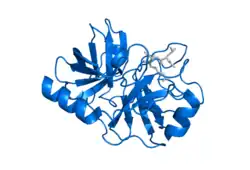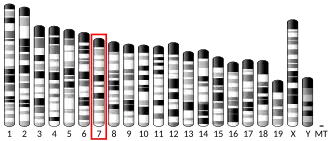Kallikrein-5, formerly known as stratum corneum tryptic enzyme (SCTE), is a serine protease expressed in the epidermis. In humans it is encoded by the KLK5 gene.[5][6][7][8][9][10] This gene is one of the fifteen kallikrein subfamily members located in a cluster on chromosome 19. Its expression is up-regulated by estrogens and progestins. Alternative splicing results in multiple transcript variants encoding the same protein.[10]
KLK5 has been suggested to regulate cell shedding (desquamation) in conjunction with KLK7 and KLK14, given its ability to degrade proteins which form the extracellular component of cell junctions in the stratum corneum. It is proposed that KLK5 regulates this process since it is able to self-activate in addition to activating KLK7 and KLK14.[11]
References
- ^ a b c GRCh38: Ensembl release 89: ENSG00000167754 – Ensembl, May 2017
- ^ a b c GRCm38: Ensembl release 89: ENSMUSG00000074155 – Ensembl, May 2017
- ^ "Human PubMed Reference:". National Center for Biotechnology Information, U.S. National Library of Medicine.
- ^ "Mouse PubMed Reference:". National Center for Biotechnology Information, U.S. National Library of Medicine.
- ^ Brattsand M, Egelrud T (Nov 1999). "Purification, molecular cloning, and expression of a human stratum corneum trypsin-like serine protease with possible function in desquamation". Journal of Biological Chemistry. 274 (42): 30033–30040. doi:10.1074/jbc.274.42.30033. PMID 10514489.
- ^ Yousef GM, Diamandis EP (Feb 2000). "The new kallikrein-like gene, KLK-L2. Molecular characterization, mapping, tissue expression, and hormonal regulation". Journal of Biological Chemistry. 274 (53): 37511–37516. doi:10.1074/jbc.274.53.37511. PMID 10608802.
- ^ Zulkifli SN, Paine LL, Greener DL, Subramaniam R (Oct 1991). "Trends in selected obstetric complications from University Hospital, Kuala Lumpur, Malaysia". International Journal of Gynaecology and Obstetrics: the Official Organ of the International Federation of Gynaecology and Obstetrics. 35 (1): 29–36. doi:10.1016/0020-7292(91)90059-E. PMID 1680072. S2CID 46529409.
- ^ Diamandis EP, Deperthes D, Lundwall Å (Jun 2006). "Proceedings of the 1st International Symposium on Kallikreins, Lausanne, Switzerland, September 1-3, 2005". Biological Chemistry. 387 (6): 635–824. doi:10.1515/BC.2006.081. PMID 16800723. S2CID 83910246.
- ^ Yamasaki K, Schauber J, Coda A, Lin H, Dorschner RA, Schechter NM, et al. (Oct 2006). "Kallikrein-mediated proteolysis regulates the antimicrobial effects of cathelicidins in skin". FASEB Journal : Official Publication of the Federation of American Societies for Experimental Biology. 20 (12): 2068–2080. doi:10.1096/fj.06-6075com. PMID 17012259. S2CID 18170331.
- ^ a b "Entrez Gene: KLK5 kallikrein-related peptidase 5".
- ^ Brattsand M, Stefansson K, Lundh C, Haasum Y, Egelrud T (Jan 2005). "A proteolytic cascade of kallikreins in the stratum corneum". The Journal of Investigative Dermatology. 124 (1): 198–203. doi:10.1111/j.0022-202X.2004.23547.x. PMID 15654974.
Further reading
- Li S, Garcia M, Gewiss R, Winuthayanon W (April 2017). "Crucial role of estrogen for the mammalian female in regulating semen coagulation and liquefaction in vivo". Plos Genetics. 13 (4): e1006743. doi:10.1371/journal.pgen.1006743. PMC 5411094. PMID 28414719.
- Diamandis EP, Yousef GM, Luo LY, Magklara A, Obiezu CV (Mar 2000). "The new human kallikrein gene family: implications in carcinogenesis". Trends in Endocrinology and Metabolism: TEM. 11 (2): 54–60. doi:10.1016/S1043-2760(99)00225-8. PMID 10675891. S2CID 25806934.
- Maruyama K, Sugano S (Jan 1994). "Oligo-capping: a simple method to replace the cap structure of eukaryotic mRNAs with oligoribonucleotides". Gene. 138 (1–2): 171–174. doi:10.1016/0378-1119(94)90802-8. PMID 8125298.
- Suzuki Y, Yoshitomo-Nakagawa K, Maruyama K, Suyama A, Sugano S (Oct 1997). "Construction and characterization of a full length-enriched and a 5'-end-enriched cDNA library". Gene. 200 (1–2): 149–156. doi:10.1016/S0378-1119(97)00411-3. PMID 9373149.
- Yousef GM, Luo LY, Diamandis EP (2000). "Identification of novel human kallikrein-like genes on chromosome 19q13.3-q13.4". Anticancer Research. 19 (4B): 2843–2852. PMID 10652563.
- Gan L, Lee I, Smith R, Argonza-Barrett R, Lei H, McCuaig J, et al. (Oct 2000). "Sequencing and expression analysis of the serine protease gene cluster located in chromosome 19q13 region". Gene. 257 (1): 119–130. doi:10.1016/S0378-1119(00)00382-6. PMID 11054574.
- Kim H, Scorilas A, Katsaros D, Yousef GM, Massobrio M, Fracchioli S, et al. (Mar 2001). "Human kallikrein gene 5 (KLK5) expression is an indicator of poor prognosis in ovarian cancer". British Journal of Cancer. 84 (5): 643–650. doi:10.1054/bjoc.2000.1649. PMC 2363783. PMID 11237385.
- Yousef GM, Scorilas A, Chang A, Rendl L, Diamandis M, Jung K, et al. (May 2002). "Down-regulation of the human kallikrein gene 5 (KLK5) in prostate cancer tissues". The Prostate. 51 (2): 126–132. doi:10.1002/pros.10067. PMID 11948967. S2CID 44645840.
- Yousef GM, Obiezu CV, Jung K, Stephan C, Scorilas A, Diamandis EP (Oct 2002). "Differential expression of Kallikrein gene 5 in cancerous and normal testicular tissues". Urology. 60 (4): 714–718. doi:10.1016/S0090-4295(02)01811-3. PMID 12385949.
- Dong Y, Kaushal A, Brattsand M, Nicklin J, Clements JA (May 2003). "Differential splicing of KLK5 and KLK7 in epithelial ovarian cancer produces novel variants with potential as cancer biomarkers". Clinical Cancer Research : an Official Journal of the American Association for Cancer Research. 9 (5): 1710–1720. PMID 12738725.
- Yousef GM, Kapadia C, Polymeris ME, Borgono C, Hutchinson S, Wasney GA, et al. (Jul 2003). "The human kallikrein protein 5 (hK5) is enzymatically active, glycosylated and forms complexes with two protease inhibitors in ovarian cancer fluids". Biochimica et Biophysica Acta. 1628 (2): 88–96. doi:10.1016/s0167-4781(03)00116-7. PMID 12890555.
- Clark HF, Gurney AL, Abaya E, Baker K, Baldwin D, Brush J, et al. (Oct 2003). "The secreted protein discovery initiative (SPDI), a large-scale effort to identify novel human secreted and transmembrane proteins: a bioinformatics assessment". Genome Research. 13 (10): 2265–2270. doi:10.1101/gr.1293003. PMC 403697. PMID 12975309.
- Caubet C, Jonca N, Brattsand M, Guerrin M, Bernard D, Schmidt R, et al. (May 2004). "Degradation of corneodesmosome proteins by two serine proteases of the kallikrein family, SCTE/KLK5/hK5 and SCCE/KLK7/hK7". The Journal of Investigative Dermatology. 122 (5): 1235–1244. doi:10.1111/j.0022-202X.2004.22512.x. PMID 15140227.
- Ishida-Yamamoto A, Deraison C, Bonnart C, Bitoun E, Robinson R, O'Brien TJ, et al. (Feb 2005). "LEKTI is localized in lamellar granules, separated from KLK5 and KLK7, and is secreted in the extracellular spaces of the superficial stratum granulosum". The Journal of Investigative Dermatology. 124 (2): 360–366. doi:10.1111/j.0022-202X.2004.23583.x. PMID 15675955.
External links
- The MEROPS online database for peptidases and their inhibitors: S01.017





